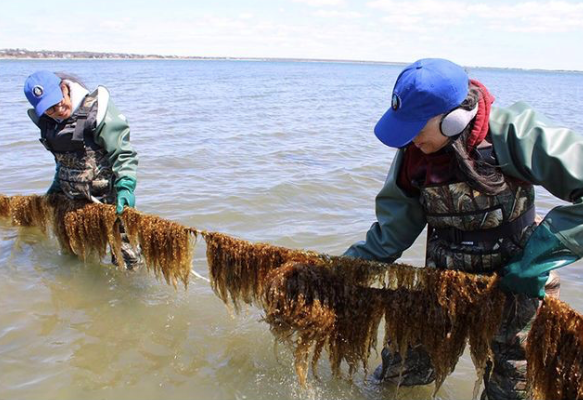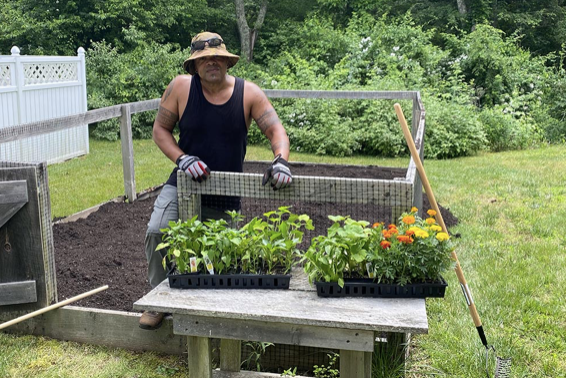
For Indigenous Peoples, there is no separation between our lives, cultures, and environments. The Earth is alive, and she has a spirit. She breathes, she bleeds, she cries, she has emotions. She nurtures us, and we heal her. She has lungs, she has bosoms, she gives birth, and she cleanses herself routinely. Our forests are home to the eldest trees on Earth that hold the wisdom of this planet. The mycelium network that has been maintained is more significant than any database anyone living today can compute without a connection to the land. When we think about our forests, we must realize there are forests on land and underwater. Indigenous Peoples advocate for not only the land on which we walk, but the land we have walked on that is now underwater, and the life that relies on the land under water.
There is evidence that shows the connection Indigenous Peoples have had to the land and land under water; scientists call it the Paleo-Arctic Tradition. Research within the last 10 years can now provide critical facts about the submerged Paleo cultural landscapes (archaeological sites that were once above water). In 2015, I was invited to an intertribal meeting to discuss the Submerged Paleocultural Landscape Project. The project was a collaboration between the Narragansett Indian Tribal Historic Preservation Office, Bureau of Ocean Energy Management, University of Rhode Island Geosciences Department, and Rhode Island Coastal Resource Management Council. In this meeting, we analyzed underwater research and findings on our ancestral territories. Roughly 200 miles off today's shoreline, there is evidence of freshwater vegetation, including quinoa seeds. Research shows that these seeds date back nearly 11,000 years, which provides valuable insight into how Indigenous people lived as stewards of the land and water long before colonization.
How Colonization Perpetuates Climate Change
Colonization has profoundly impacted Indigenous communities and their ability to continue to be stewards of the land and water. The arrival of European settlers brought with it a new way of looking at the world, one that was driven by the desire to extract resources and exploit the land for profit. This approach to the environment was fundamentally at odds with the traditional practices of Indigenous communities, which were rooted in a deep respect for the natural world and an understanding of its interconnectedness with all living things.
As European settlers began to expand their territories and claim new lands, they often forced Indigenous communities to relocate or abandon their traditional ways of life. There is a written account by Roger Williams that describes three or four Narragansett women watching the English settlers struggling to cut down a tree. He described these women as laughing hysterically among themselves at the settlers’ lack of knowledge on how to properly take down trees. The settlers would spend countless hours trying to saw down old growth trees, whereas the local Indigenous people used fire as a tool to fell a tree. This ancient method had many benefits to old growth forests, as using fire would help to bring nitrogen back into the soil for new life to grow.

Rebecca Geina during a rally for Shinnecock access to the beach in Southampton, NY. Photo by Chenae Bullock.
Old growth forests are some of the most biologically diverse ecosystems on the planet and the indigenous plant life plays a crucial role in maintaining this diversity. They store large amounts of carbon, which helps to mitigate climate change. The forests are home to indigenous plants that maintain the biologically diverse ecosystems around the planet. Indigenous plant life plays an important role in this process, as plants absorb carbon dioxide from the atmosphere and store it in their tissues. If we were to take an assessment over the last 400 years, we would see the number of old growth forests have dwindled to near extinction due to deforestation from settlers on Indigenous lands.
With the advancement of technology, we have seen the same impact on the seafloor where deforestation is caused by activities such as bottom trolling, dredging, and oil and gas exploration. This can lead to destruction of coral reefs, loss of habitat for marine life, and disruption of the food chain. Deforestation of both land and sea can have long-term consequences for the environment, and both require urgent action to protect the environment.
Although not all Indigenous people were forcibly removed from their homelands, most, if not all, Indigenous ecological knowledge practices were outlawed. This displacement had a devastating effect on the environment, as Indigenous Peoples were often the primary stewards of the land and water in their communities. Without their knowledge and expertise, the natural resources of these areas were left vulnerable to overuse and pollution, causing irreparable damage to ecosystems and threatening the survival of many species.

Quahog shell as an ecosystem for other shells on the Shinnecock shoreline. Photo by Chenae Bullock.
Deforestation on Land and the Seafloor
Written, first hand accounts of explorers during the initial period of colonization describe massive old-growth forests so interconnected that a squirrel could hop from tree to tree from Maryland to Maine without ever touching the ground. They likened the ground to a trampoline or a track, it was so soft and healthy. Over time, as settlements turned into cities such as Baltimore, Dover, Newark, New York City, Providence, Boston, and Portland, we lost the interconnectedness of the trees. The removal of trees and native plants has caused erosion as the soil can no longer be stabilized. With the settlement of people came the introduction of invasive plants. Invasive plants can cause significant damage to forests, as they can outcompete native species and disrupt the balance of the ecosystem. There are some laws today that protect invasive species yet outlaw native plants—an uncanny parallel to the history of Indigenous Peoples.
Both the land and seafloor experience the same issues of deforestation, illegal logging, dredging, climate change, invasive species, and pollution. Deforestation is one of the most pressing international forest issues, as it destroys vital habitats and ecosystems. Deforestation of the seafloor is known as seafloor bottom trolling. The ocean seafloor generates about half of the atmosphere's oxygen, about as much per year as all land plants. When we lose seafloor forest, we lose phytoplankton. Like plants, phytoplankton get their energy from carbon dioxide through photosynthesis and are very important in carbon cycling. Phytoplankton forms the basis of the marine food chain and provides half the ocean's oxygen, along with trees, shrubs, and grasses. Hurricanes churn the sea, bringing up nutrients like nitrogen, phosphate, and iron from the ocean's depths and introducing them to the surface levels where plankton live. The phytoplankton bloom and spread, and marine life grows with it. If their numbers continue to decrease, the populations of species that depend on phytoplankton will also drop.
As global warming worsens, humanity is responsible for coming together to save this planet. By preserving forests, we can help ensure our oceans remain healthy and productive. Protecting the forest floor at sea is essential for maintaining the balance of the marine ecosystem. It helps to provide food and shelter for a variety of species, and it also helps to reduce the amount of sediment and pollutants that enter the ocean. Additionally, preserving the undersea forest floor, also known as seagrass meadows, helps to protect coastal areas from erosion and flooding by acting as a natural barrier to reduce the energy of waves and currents. The dense root system and the flexible blades of seagrass plants can dampen the force of the waves and reduce their erosive power, thus helping to reduce the impacts of climate change.

Shinnecock Kelp Farmers Donna Collin-Smith, right, and Danielle Hopson Begun check a line of kelp being grown in Shinnecock Bay on Eastern Long Island. Photo by Chris Berlinger.
Centering Indigenous Ecological Knowledge
In recent years, efforts have been made to revitalize ancient Indigenous Traditional Knowledge, or Indigenous Traditional Ecological Knowledge, to help save the planet. Within the last 20 years, Indigenous Peoples have advocated for the right to protect the forests. The battle between Western science and Traditional Knowledge has been waged since the beginning of colonization. However, with the advancement of Indigenous Traditional Ecological Knowledge, Indigenous people who are still connected to the land and water have been willing to share their knowledge for the betterment of the world.
One great example of this is the Shinnecock Kelp Farmers. Started by six Shinnecock women, this sustainable and innovative project grows and harvests kelp, a type of seaweed. Kelp is known to be a natural carbon sink, meaning that it absorbs carbon dioxide from the atmosphere and helps to mitigate climate change. In addition, kelp provides habitat and food for various marine animals, such as fish and shellfish, which helps to support the ocean's ecosystem. Kelp farming also has the potential to reduce the need for harmful chemical fertilizers and pesticides used in land-based agriculture.

Rocky Johnson (Narragansett) leads the Indigenous Roots Forever Program. Photo by Chenae Bullock.
Policymakers are increasingly recognizing the importance of protecting forests and working with Indigenous Peoples to ensure their rights and interests are respected. They are taking steps to ensure that forests are managed sustainably and that Indigenous Peoples are consulted and involved in decision-making. This includes developing policies and legislation to protect forests, recognizing the rights of Indigenous Peoples, and providing financial and technical support to help them manage their forests. Indigenous Peoples comprise just over six percent of the world's population. However, they steward over 25 percent of the world's land surface and support approximately 80 percent of its biodiversity. Indigenous Peoples desperately need more funding and support to help the world's biodiversity.
There are many ways to support the biocentric efforts of Indigenous Peoples, but it is essential to start by recognizing and respecting Indigenous Traditional Knowledge and practices and acknowledging Indigenous Peoples’ expertise in managing their lands and waters. Collaboration with Indigenous Peoples is also critical to thriving forest and seafloor conservation initiatives. It is essential to engage with them, listen to their perspectives, and work together to develop strategies that benefit both the environment and their communities. Providing training and resources to Indigenous communities can help them build the capacity to manage their lands and waters. This can include training in sustainable forestry practices, marine conservation techniques, and ecotourism development. Indigenous communities have a vested interest in protecting their lands and waters, and supporting their efforts can effectively conserve forests and the seafloor.

Tree Sitters have built shelters in the canopies of the trees to prevent deforestation in Atlanta. Photo by the Defenders of the Atlanta Forest.
Ways to support the biocentric efforts of Indigenous Peoples:
- Learn about the management efforts of Indigenous communities local and worldwide
- Help to amplify the voices in your local area
- Become an ally, and support a local tribal community near you
- Donate to Native and Indigenous-led organizations
- Support, follow, like and share Indigenous on social media platforms
- Hashtags are a great way to become knowledgeable about current issues Indigenous People are facing. Be sure to check out the following to learn, like, follow, donate, or share.
Organizations and Movements to Follow:
- Defend Atlanta Forest
- Indigenous Roots Forever Program
- Community Forest & Open Space Conservation
- Shinnecock Kelp Farmers
- Fairy Creek Blockade
- Sly Fox Den Restaurant Food Sovereignty
- Indigenous Seed Keepers Network
- Wet'suwet'en Checkpoint
—Chenae Bullock is an enrolled Shinnecock Indian Nation Tribal member and descendant of the Montauk Tribe in Long Island, New York. She is a community leader, water protector, cultural preservationist, Indigenous perspective historian, and humanitarian. She is also the founder and CEO of Moskehtu Consulting, LLC, and a 2022-2023 Cultural Survival Writer in Residence.
Top photo: Chenae Walking through an old-growth forest in Georgia. Photo by Gabriel Rudd.



